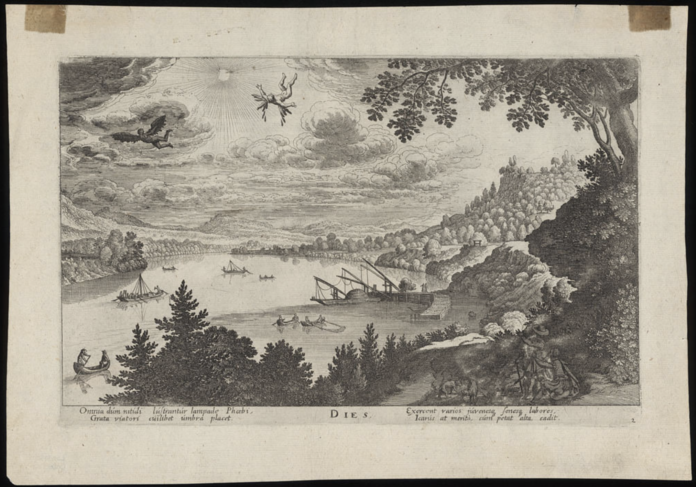This desire to elevate oneself above one’s environment—to conquer the ocean of air—can be seen as a perennial struggle evident in nearly every civilization from classical times to the early twentieth century. As Wilbur spoke that night in his typically understated style, he seemed to suggest that, instead of achieving this age-old dream of mankind, he and Orville had been merely participants in an ancient and ongoing human struggle.
From the beginning of recorded history, the theme of flight can be found in myth and legend, as well as in art, literature, and organized religion. Almost every culture has its own version of winged angels and devils, horses and dragons, as well as flying carpets and chariots.
The exhibition begins with the classic flying myth of Daedalus and Icarus, and uses rare books, prints, and manuscripts to look at the idea of flight through ancient times. The exhibition brings to light a strikingly symbolic uniformity—that the idea of flight suggests freedom and connotes supernatural power in most cultures.
Chariot of Fire
One of the best known biblical stories of flight is the ascension of the Hebrew prophet Elijah, who was picked up by a chariot and horses of fire and “went up by a whirlwind into heaven.” In this story, flying can be said to represent the idea of the afterlife or even reincarnation.
Wings of Wax
The imprisoned architect and sculptor, Daedalus, who fashioned wings of wax, feathers, and twine to escape King Minos of Crete. Daedalus successfully flew to safety, but his son, Icarus, plunged to his death, having flown too near the sun. Icarus is destroyed by excessive pride in his powers.
The Spirits of Flight
Taken sometime between 1854 and 1860 during the first generation of photography, this daguerreotype shows a small marble work by the celebrated American sculptor, Erastus Dow Palmer (1817–1904). In his bas-relief sculpture titled “The Spirit’s Flight,” Palmer captures the traditional notion that winged beings are ethereal, and that flight is a non-human attribute.
Winged Horse
This winged horse employed by the Soviet Union in 1920 to encourage mass education with the slogan, “Literacy—the Path to Communism” is a variation of Pegasus. The torch-bearing young man holding an open book and riding a powerful steed soaring high above the city is an image designed to inspire. Linking communist ideology to the winged, immortal horse of Greek mythology aligns that political doctrine with an easily understandable and very potent idea—that to fly is to dominate, to conquer.
French Ballooning
This lithograph of a balloon in the colors of the French flag was signed by the French professional balloonist Jules Duruof on June 6, 1874—little more than a year after he and his wife were rescued at sea. When the mayor forbade his ascent because of threatening weather, the crowd questioned his courage. Saying, “Let us show then that we are not afraid to die,” Duruof and his wife disappeared into the darkness above a stormy sea and were given up for lost. News of their rescue was cheered by all.
Reflexive Analysis
This sort of anthology type analysis explores an exhibition from the Library of Congress celebrating the Wright brothers’ flight titled, The Dream of Flight. These various works across time explore different themes of and ways of depicting flight, as well as its story in our collective consciousness. The above were selected to show how artists have used flight in different ways, allowing me to consider different symbols and feeling associated with it.
I found the idea of flight as a means of conquering as interesting. To conquer the skies and the forces of nature. Once upon a time to fly was to conquer what we thought possible, our own human limits. To fly is to conquer nature, and to conquer nature is to achieve the power of gods. This power can be dangerous though as Icarus’ story and that of the first man to die in balloon flight show us. Flight is also a means of conquering fear and death as depicted in the last story. There is an element of proving oneself brave when attempting these sorts of feats for the first many few times. Finally there is a level of conquering the competition as well. Going further or higher or faster than the next is human nature and applies to the story of flight as well.
This could perhaps translate the nature of these feelings into some sort of design conjecture taking form of a game, a race, a build then compete scenario?
Sources
Durer, A., Blake, W., da Vinci, L., Franklin, B., Tissandier, A., Lilienthal, O., Palmer, E. D., Besna, P. A., de La Follier, L. G., Terzi, F. L., Charles, J. A. C., Means, J., & Chanute, O. (2003, October 4). The dream of flight the dream. Library of Congress. https://www.loc.gov/exhibits/dreamofflight/dream-dream.html




